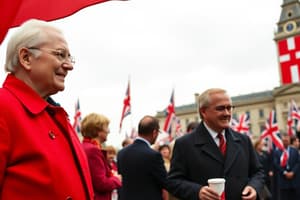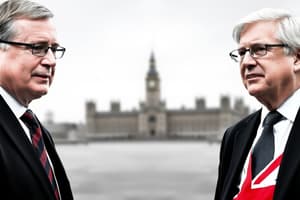Podcast
Questions and Answers
Which of the following best describes the foreign policy stance adopted by both the Labour and Conservative parties in England during the specified period?
Which of the following best describes the foreign policy stance adopted by both the Labour and Conservative parties in England during the specified period?
- Isolating themselves from international affairs to focus on domestic economic recovery and growth.
- Prioritizing alliances with Eastern European nations to counterbalance Western influence.
- Maintaining a neutral position on global conflicts while strengthening ties with the USA and Western European countries. (correct)
- Actively intervening in various global conflicts to promote decolonization and British interests.
What was the primary factor that led to the Labour Party's victory in the 1974 elections, as suggested by the text?
What was the primary factor that led to the Labour Party's victory in the 1974 elections, as suggested by the text?
- Growing dissatisfaction and unrest within British society, potentially fueled by economic or social issues. (correct)
- A significant shift in foreign policy that resonated with the British public.
- Widespread public support due to the charismatic leadership of the Labour Party leader.
- Strategic alliances formed with other political parties to gain a majority in Parliament.
Based on the provided text, what can be inferred about the extent of the Labour Party's victory in the 1974 elections?
Based on the provided text, what can be inferred about the extent of the Labour Party's victory in the 1974 elections?
- The Labour Party formed a coalition government with other parties to secure power.
- The Labour Party achieved a decisive victory, securing a large majority in Parliament.
- The Labour Party's victory was marginal, indicating a closely divided electorate. (correct)
- The Labour Party's victory was primarily due to widespread electoral fraud.
How did the political conditions of the employees change during the period described in the text?
How did the political conditions of the employees change during the period described in the text?
What does the text suggest about the underlying causes of the 'protests' that 'shook British society'?
What does the text suggest about the underlying causes of the 'protests' that 'shook British society'?
What is the most accurate inference regarding the role of the 'welfare state', based on the provided glossary definition?
What is the most accurate inference regarding the role of the 'welfare state', based on the provided glossary definition?
Considering the information provided and the image caption, what can be inferred about Winston Churchill's political standing during the period mentioned?
Considering the information provided and the image caption, what can be inferred about Winston Churchill's political standing during the period mentioned?
What is the most likely reason the textbook includes questions that prompt students to 'Think - Interpret - Investigate - Conclude'?
What is the most likely reason the textbook includes questions that prompt students to 'Think - Interpret - Investigate - Conclude'?
Which of the following best describes the core difference in economic policy between the Conservative and Labour parties in Great Britain during the period 1945-1974?
Which of the following best describes the core difference in economic policy between the Conservative and Labour parties in Great Britain during the period 1945-1974?
What was not a key component of the Labour Party's welfare state program implemented after World War II?
What was not a key component of the Labour Party's welfare state program implemented after World War II?
How did the Conservative Party's approach to privatization compare to their stated economic program when they came to power in 1951?
How did the Conservative Party's approach to privatization compare to their stated economic program when they came to power in 1951?
Which sectors were nationalized under the Labour government's program?
Which sectors were nationalized under the Labour government's program?
What was a significant reason for the alternating power dynamic between the Conservative and Labour parties during the 1945-1974 period?
What was a significant reason for the alternating power dynamic between the Conservative and Labour parties during the 1945-1974 period?
What was the impact of Labour's economic policies on the British electorate?
What was the impact of Labour's economic policies on the British electorate?
Which social reforms were implemented by the Labour government using the income from nationalized industries?
Which social reforms were implemented by the Labour government using the income from nationalized industries?
What was the main reason Labour lost ground, leading to elections in 1970, after winning the elections in 1964?
What was the main reason Labour lost ground, leading to elections in 1970, after winning the elections in 1964?
How did the Labour Party's political program in 1945 aim to address the economic crisis in Great Britain?
How did the Labour Party's political program in 1945 aim to address the economic crisis in Great Britain?
What can be inferred from the continued construction of worker's houses under the Conservative Party?
What can be inferred from the continued construction of worker's houses under the Conservative Party?
Flashcards
Welfare State
Welfare State
Refers to the comfort or improvement of living conditions in a society related to income and its effects.
Impact of Protests
Impact of Protests
British society experienced significant upheaval due to worker dissatisfaction and demands for better conditions.
1974 Election Result
1974 Election Result
The Labour Party's victory in 1974 was achieved by a narrow margin, highlighting a closely divided electorate.
Foreign Policy Consensus
Foreign Policy Consensus
Signup and view all the flashcards
Churchill's Leadership
Churchill's Leadership
Signup and view all the flashcards
Governing party in 1945
Governing party in 1945
Signup and view all the flashcards
Labour Program Basics
Labour Program Basics
Signup and view all the flashcards
Welfare State Support
Welfare State Support
Signup and view all the flashcards
Conservative Party (UK)
Conservative Party (UK)
Signup and view all the flashcards
Labour Party (UK)
Labour Party (UK)
Signup and view all the flashcards
Nationalization
Nationalization
Signup and view all the flashcards
Privatization
Privatization
Signup and view all the flashcards
Winston Churchill
Winston Churchill
Signup and view all the flashcards
Labour Party (1945)
Labour Party (1945)
Signup and view all the flashcards
Free Medical Care (UK)
Free Medical Care (UK)
Signup and view all the flashcards
Conservative Party (1951)
Conservative Party (1951)
Signup and view all the flashcards
Workers' Housing (UK)
Workers' Housing (UK)
Signup and view all the flashcards
Study Notes
- In Great Britain, from 1945-1974, the most important political parties were the Conservative and the Labour parties.
- The former's program supported the free market.
- The latter pursued the creation of a welfare state.
- From 1946-1974, the respective parties alternated in governing the country.
- After WWII, the two traditional parties on the British political scene were the Conservative and Labour parties.
- During the War, the two parties formed an antifascist coalition led by Winston Churchill of the Conservative Party.
- The first post-war elections that took place in 1945 were won by the Labour Party.
- The Labour Party's political program, which promised a welfare state, strongly appealed to the British electorate.
- It raised the expectations of the British society, which had been plagued by the economic repercussions of the war, for a swift resolution of the crisis.
- The Labour Party's program was based on two key pillars:
- Nationalization of key sectors of the economy
- Radical improvement of social services
- Industries like coal, steel, electricity, gas, transportation (air, road, rail), healthcare, and banking were nationalized with the creation of state-owned social security institutions.
- Income from these sectors was used by the Labour government to implement social reforms, such as free medical care for all, unemployment benefits, assistance to vulnerable groups, maternity leave, and better treatment of women.
- These reforms also encompassed housing.
- The Conservative's economic policies did not meet expectations.
- The 1951 elections brought the Conservative Party to power.
- Their program promised economic freedom and privatization of the state sector.
- However, in practice, they followed a cautious policy with the privatization of the state sector progressing at a slow pace.
- Construction of workers' housing continued to provide housing for workers, the homeless, and the vulnerable.
- Although the Conservatives constituted a right-wing political force, they did not overturn the reforms for the welfare state that had been implemented by the Labour government.
- Conservative governments remained in England until 1964.
- When the Labour Party won that year's elections, it did not significantly deviate from the Conservatives' policies in the economic sector.
- However, their failure to achieve the economic changes they promised in the 1970 elections led to power being handed back to the Conservatives.
- The alternation of the two parties in power can be attributed to the fact that their programs differed very little.
- However, this political situation left a large number of workers unhappy, who expressed their dissatisfaction through strikes and demonstrations that rocked British society.
- As a result, the Labour Party won the 1974 elections by a very small margin.
- In its foreign policy, the two parties followed the same line, which was based:
- Friendship with the US and Western European countries.
- Support for decolonization processes
- Maintaining a neutral stance in various global disputes
- Welfare state refers to the comfort, or improvement of the living conditions of a society in relation to income and the extent to which conditions affect it.
Studying That Suits You
Use AI to generate personalized quizzes and flashcards to suit your learning preferences.




